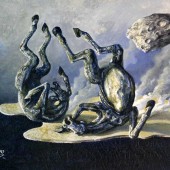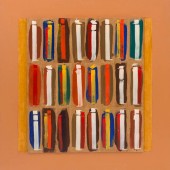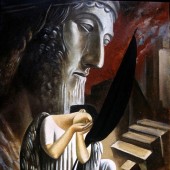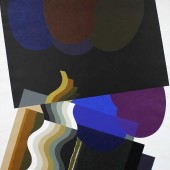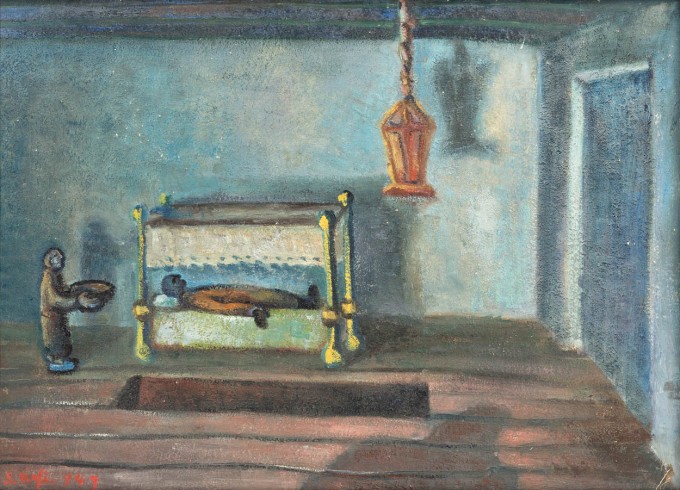
Samir Rafi’s Life’s Tragedy is a painting produced in 1949, shortly after establishment of the Contemporary Art Group by artist and educator Husayn Youssef Amin and Kamal Youssef. The group, which included artists like Abdel Hadi El-Gazzar and Hamed Nada, sprang from an anti-colonial nationalist consciousness, and was inspired by folk symbolism, often depicting the working class and urban life. This trend in realism was joined by the writer Albert Cossery and others, for whom Rafi and his contemporaries were producing illustrations for literary magazines. This painting is one of many belonging to a new milieu of social criticism and story-telling. The recumbent figure appears deceased or near death with an attendant, or perhaps a family member, bringing what appears to be an empty bowl. Looming sense of death is emphatically represented by the precarious placement of a rectangular grave in the wooden floor at the figure’s bedside.
Rafi’s first exhibit with the Egyptian Surrealist group Art et Liberté was in 1943 when he was only 17. A graduate of the School of Fine Arts in Cairo he earned a Ph.D. in art history at the Sorbonne in Paris and later returned to work as a Professor at the School of Fine Arts in Cairo, writing several influential texts that included one on the influence of the 1952 Free Officers Revolution on art in Egypt.
أبدع الفنان سمير رافع لوحته الشهيرة “مأساة الحياة” في عام 1949، عقب فترة قصيرة من تأسيس “جماعة الفن المعاصر” على يد الفنان والمعلم حسين يوسف أمين وكمال يوسف. وانبثقت هذه الجماعة، التي ضمت فنانين كثر أمثال عبد الهادي الجزار وحامد ندى، من صميم الوعي الوطني المناهض للاستعمار. واستمدت إلهامها من الرمزية الشعبية، فهي غالباً ما تصور الطبقة العاملة والحياة الحضرية. وانضم إلى هذا التوجه الواقعي الكاتب ألبير قصيري وآخرون غيره والذين كان رافع ومعاصروه يبدعون رسومات توضيحية لمجلاتهم الأدبية. وهذه اللوحة هي واحدة من اللوحات التي تنتمي لوسط جديد من النقد الاجتماعي ورواية القصص. ويظهر فيها شخص راقد يبدو كأنه توفي أو يلفظ أنفاسه الأخيرة، وبقربه شخص آخر أو ربما فرد من أفراد عائلته يحمل شيئاً يبدو أشبه بوعاء فارغ. ويتمثل الشعور الوشيك بالوفاة بشكل واضح من خلال وضع قبر مستطيل في الأرضية الخشبية إلى جانب سرير الشخص الراقد.
وقدم رافع معرضه الأول وهو لم يتجاوز السابعة عشرة من عمره، بالتعاون مع المجموعة المصرية السريالية “الفن والحرية” في عام 1943. وبعد تخرجه من كلية الفنون الجميلة في القاهرة، حصل على درجة الدكتوراه في تاريخ الفن من جامعة السوربون في باريس. وعاد بعدها للعمل كأستاذ في كلية الفنون الجميلة في القاهرة، وكتب العديد من النصوص المؤثرة التي تناولت إحداها تأثير ثورة الضباط الأحرار على الفن في مصر عام 1952.




